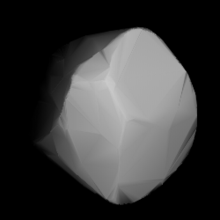 | |
| Discovery[1] | |
|---|---|
| Discovered by | P. M. Henry |
| Discovery date | 4 November 1875 |
| Designations | |
| (154) Bertha | |
| Pronunciation | /ˈbɜːrθə/[2] |
| A875 VD | |
| Main belt | |
| Orbital characteristics[3][4] | |
| Epoch 31 July 2016 (JD 2457600.5) | |
| Uncertainty parameter 0 | |
| Observation arc | 130.75 yr (47758 d) |
| Aphelion | 3.44 AU (515.21 Gm) |
| Perihelion | 2.95 AU (441.30 Gm) |
| 3.20 AU (478.26 Gm) | |
| Eccentricity | 0.077261 |
| 5.72 years (2,087.9 d) | |
Average orbital speed | 16.63 km/s |
| 125.046° | |
| 0° 10m 20.734s / day | |
| Inclination | 20.9724° |
| 36.7441° | |
| 159.722° | |
| Earth MOID | 1.95 AU (291.94 Gm) |
| Jupiter MOID | 1.53 AU (229.03 Gm) |
| TJupiter | 3.087 |
| Physical characteristics | |
| Dimensions | 184.93±3.6 km[3] 186.85±1.83 km[5] |
| Mass | (9.19±5.20)×1018 kg[5] |
Mean density | 2.69±1.52 g/cm3[5] |
Equatorial surface gravity | 0.0517 m/s² |
Equatorial escape velocity | 0.0978 km/s |
| 25.224 h (1.0510 d)[3][6] | |
| 0.0480±0.002[3] 0.0483 ± 0.0107[7] | |
| Temperature | ~156 K |
| C[7] | |
| 7.58,[3] 7.530[7] | |
Bertha (minor planet designation: 154 Bertha) is a main-belt asteroid. It was discovered by the French brothers Paul Henry and Prosper Henry on 4 November 1875, but the credit for the discovery was given to Prosper. It is probably named after Berthe Martin-Flammarion, sister of the astronomer Camille Flammarion.[8]
Observations performed at the Palmer Divide Observatory in Colorado Springs, Colorado in during 2007 produced a light curve with a period of 22.30 ± 0.03 hours and a brightness range of 0.10 ± 0.02 in magnitude. A 1998 measurement gave a value of 27.6 hours, which doesn't fit the PDO data.[9] In 2011, observations from the Organ Mesa Observatory in Las Cruces, New Mexico were used to determine a rotation period of 25.224 ± 0.002 hours with a brightness variability of 0.10 ± 0.01 magnitude, ruling out previous studies.[6]
This is classified as a C-type asteroid[7] and it has an estimated diameter of about 187 km.[5]
References
- ^ "Discovery Circumstances: Numbered Minor Planets". International Astronomical Union - Minor Planet Center.
- ^ "Bertha". Oxford English Dictionary (Online ed.). Oxford University Press. (Subscription or participating institution membership required.)
- ^ a b c d e Yeomans, Donald K., "154 Bertha", JPL Small-Body Database Browser, NASA Jet Propulsion Laboratory, retrieved 12 May 2016.
- ^ "The Asteroid Orbital Elements Database". astorb. Lowell Observatory.
- ^ a b c d Carry, B. (December 2012), "Density of asteroids", Planetary and Space Science, vol. 73, pp. 98–118, arXiv:1203.4336, Bibcode:2012P&SS...73...98C, doi:10.1016/j.pss.2012.03.009. See Table 1.
- ^ a b Pilcher, Frederick (April 2012), "Rotation Period Determinations for 31 Euphrosyne, 65 Cybele, 154 Bertha 177 Irma, 200 Dynamene, 724 Hapag, 880 Herba, and 1470 Carla", The Minor Planet Bulletin, vol. 39, no. 2, pp. 57–60, Bibcode:2012MPBu...39...57P.
- ^ a b c d Pravec, P.; et al. (May 2012), "Absolute Magnitudes of Asteroids and a Revision of Asteroid Albedo Estimates from WISE Thermal Observations", Asteroids, Comets, Meteors 2012, Proceedings of the conference held May 16–20, 2012 in Niigata, Japan, no. 1667, Bibcode:2012LPICo1667.6089P. See Table 4.
- ^ Schmadel, Lutz D. (2012), Dictionary of Minor Planet Names (6th ed.), Springer, p. 27, ISBN 3642297188.
- ^ Warner, Brian D. (September 2007), "Asteroid Lightcurve Analysis at the Palmer Divide Observatory", The Minor Planet Bulletin, Bibcode:2007MPBu...34...72W.
External links
- Lightcurve plot of 154 Bertha, Palmer Divide Observatory, B. D. Warner (2007)
- Asteroid Lightcurve Database (LCDB), query form (info Archived 16 December 2017 at the Wayback Machine)
- Dictionary of Minor Planet Names, Google books
- Asteroids and comets rotation curves, CdR – Observatoire de Genève, Raoul Behrend
- Discovery Circumstances: Numbered Minor Planets (1)-(5000) – Minor Planet Center
- 154 Bertha at AstDyS-2, Asteroids—Dynamic Site
- 154 Bertha at the JPL Small-Body Database
